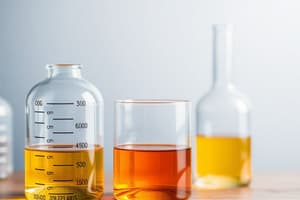Podcast
Questions and Answers
A beaker can be used to accurately measure the volume of a liquid.
A beaker can be used to accurately measure the volume of a liquid.
False (B)
What is the main purpose of a bulb pipette?
What is the main purpose of a bulb pipette?
- To measure the volume of a flask
- To temporarily store solutions or solvents
- To store liquid solvents or solutions
- To transfer very precise volumes from one container to another (correct)
What is the unit of molar concentration?
What is the unit of molar concentration?
mol/L
The concentration of a chemical substance or compound in a solution is often given in ______________, or mol/L.
The concentration of a chemical substance or compound in a solution is often given in ______________, or mol/L.
What is the name of the device used to measure the mass of a substance?
What is the name of the device used to measure the mass of a substance?
Match the following laboratory equipment with their purposes:
Match the following laboratory equipment with their purposes:
A blue-capped bottle is used to measure the volume of a flask.
A blue-capped bottle is used to measure the volume of a flask.
What is the molar mass of NaCl (table salt)?
What is the molar mass of NaCl (table salt)?
What is the purpose of a volumetric flask in a chemistry lab?
What is the purpose of a volumetric flask in a chemistry lab?
Molar mass is defined as the mass of 0.5 mol of a pure substance expressed in grams.
Molar mass is defined as the mass of 0.5 mol of a pure substance expressed in grams.
What is the formula to find the molarity of a solution?
What is the formula to find the molarity of a solution?
The relationship between mass and amount in mol for any chemical substance is governed by its _______________________.
The relationship between mass and amount in mol for any chemical substance is governed by its _______________________.
What is the instrument of high precision used to obtain just the right amount of substance?
What is the instrument of high precision used to obtain just the right amount of substance?
A volumetric flask comes with a stopper to seal off the flask for mixing.
A volumetric flask comes with a stopper to seal off the flask for mixing.
The symbol for amount in moles is _______________________.
The symbol for amount in moles is _______________________.
Match the following laboratory equipment with their descriptions:
Match the following laboratory equipment with their descriptions:
What is the purpose of a micropipette?
What is the purpose of a micropipette?
The upper and lower limits of the micropipette should be exceeded when using it.
The upper and lower limits of the micropipette should be exceeded when using it.
What is the formula for molarity?
What is the formula for molarity?
The concentration of a chemical substance or compound in a solution is often given in ______________ per liter.
The concentration of a chemical substance or compound in a solution is often given in ______________ per liter.
How many moles are in 15 grams of lithium?
How many moles are in 15 grams of lithium?
A micropipette is used to weigh small amounts of solids.
A micropipette is used to weigh small amounts of solids.
Match the following equipment with their uses:
Match the following equipment with their uses:
Study Notes
Laboratory Equipment and Procedures
- An analytical balance is used to obtain precise amounts of substances.
- Glassware is used for quantitative transfer and solution preparation.
Volumetric Flask
- A standard piece of glassware in a chemistry lab.
- Used for creating solutions with high accuracy of concentration.
- Has a single calibration mark and a stopper for sealing.
Mass and Moles Conversions
- The relationship between mass and amount in moles is governed by molar mass.
- Molar mass is defined as the mass of 1 mole of a pure substance expressed in grams.
- Symbols and units: mass [g] = m, amount [mol] = n, molar mass [g/mol] = M.
Examples of Mass and Moles Conversions
- NaCl (table salt) has a molar mass of 58.44 g/mol.
- H₂O (water) has a molar mass of 18.02 g/mol.
Molar Concentration
- Concentration of a chemical substance or compound in a solution is often given in moles per liter, or mol/L.
- Molarity is represented by the symbol M and is calculated by dividing the amount in moles (n) by the volume in liters (V): M = n/V.
Other Laboratory Equipment
- Beaker: used for temporarily storing solutions or solvents.
- Blue-capped bottle: used for storing liquid solvents or solutions.
- Bulb pipette: used for transferring very precise volumes from one container to another.
- Measuring cylinder: used for transferring small amounts of liquids.
Micropipette
- Used for transferring small amounts (< 1 ml) of liquids.
- Identified by the number near the display window.
- Steps to follow when using the micropipette: select the volume, set the tip, and use appropriate tips.
Sample Questions and Exercises
- Examples of converting between mass and moles, and calculating molarity.
- Remember to always select the smallest size pipette and use appropriate tips.
Solution Preparation
- Involves preparing an aqueous solution of a given molarity from a water-soluble salt.
- Steps include determining the exact amount of salt needed, using an analytical balance, and preparing the solution using a volumetric flask.
Studying That Suits You
Use AI to generate personalized quizzes and flashcards to suit your learning preferences.
Description
In this quiz, you will practice calculating molarity in a chemistry lab setting. You'll use analytical balances to measure substances and apply the formula to find molarity. Take your time and get it right!




